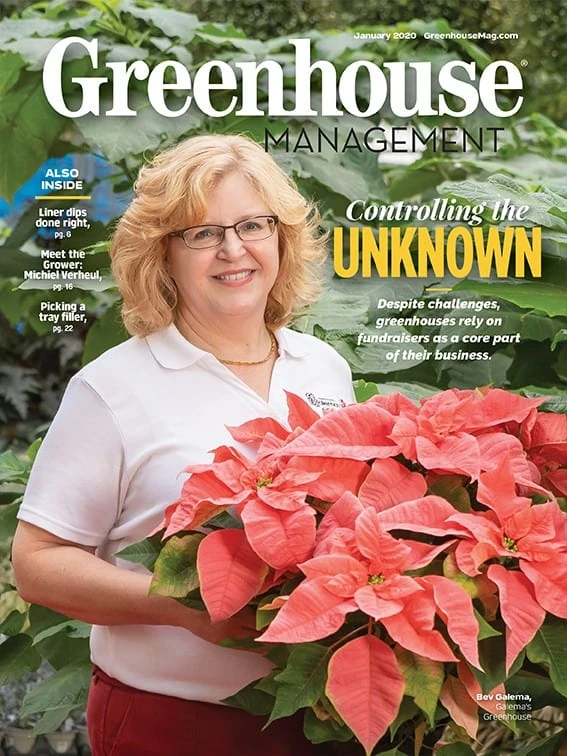

Most commonly known as feeders of trees and shrubs, scales are also a nuisance of the mature plants in interior plantscapes and conservatories. But these insect pests can also find their way into commercial greenhouses if growers produce or bring in specific plants.
Growers are more likely to see scales on tropicals and hibiscus, for example, than on many annuals and perennials, says Raymond Cloyd, professor and extension specialist in horticultural entomology and plant protection at Kansas State University. “If they’re growing tropical plants, then they run the risk of higher possibility of scale infestations, because scales, like mealybugs, tend to feed on … woody plants that are well-established,” he says.
Determining if they have scales, and if so, what kind, can help growers decide how to control them.
Telling apart hard and soft scales
Scales can be either hard or soft, Cloyd says. It is important to differentiate between these two types because they require different methods of control.
Soft scales are usually more convex or “helmet-shaped,” Cloyd says, while hard scales, also known as armored scales, tend to be flatter.
Indirect damage can also help growers identify which of the two they might have, Cloyd says. “If you see honeydew, you’ve got a soft scale,” he says. “If you see ants, you’ve got soft scale because ants will feed on the honeydew and farm the soft scales from plant to plant.” Black sooty mold can also grow on the honeydew of soft scales. The absence of honeydew, ants and black sooty mold indicate that a scale is hard.
Like aphids and whiteflies, soft scales feed in the phloem sieve tubes, Cloyd says. Hard scales, meanwhile, feed intercellularly and take up little plant sap.
Outdoors, scales need to overwinter. Compared to hard scales, soft scales have fewer generations but lay more eggs per generation. But this all gets turned on its head in a greenhouse environment, where scales likely don’t need to overwinter.
“In a greenhouse scenario, I would find it very difficult to figure that they’d even overwinter,” Cloyd says. “I would think they would just keep going through multiple generations. There wouldn’t be a need to overwinter when you’ve got temperature that’s conducive for development, growth and reproduction year-round.”

Other identification tips
In addition to determining whether they have soft scales or hard scales, growers need to ascertain whether their scales are alive, and if so, what specific type of scale they have within the hard and soft categories.
When scales die, they remain stuck to plants, Cloyd says. Because of this, some growers may think they have a current problem with scales, when really, those scales are dead.
“If you want to make sure they’re alive, then you can take some tweezers or something sharp like a razorblade, flip them on their back and look at them under a microscope or a hand lens — a good one — and see if the legs are moving,” Cloyd says. “If it’s a hollow shell, then it was from a previous generation.”
Because scales don’t fly, growers must do visual inspections, he says. Tropical plant growers need to know exactly what plants they are growing because certain types of scale feed on them.
Brown soft scale, for instance, feeds on citrus and weeping fig.
“It’s probably the major soft scale pest we encounter in interior plantscapes and conservatories, because it feeds on citrus and weeping fig in a broad range, and it produces a tremendous amount of honeydew,” Cloyd says.
To identify specific scales, growers can send samples to a diagnostic lab, entomologist, or refer to extension publications. Cloyd, for instance, wrote the eight-page factsheet, “Scale Insect Pests.” He adds that books can also help with scale identification.
“[Growers] need to be diligent about scouting because scales, like mealybugs — I call them ‘sneaky pests’ — will all of a sudden be there, then your options for control or management are much limited,” Cloyd says. If they are growing a plant that has known susceptibility to scales, they should scout attentively or consider a quarantine to prevent problems from exacerbating.
Control options
Control methods vary depending on scale type and include beneficial insects and insecticides, Cloyd says.
The parasitoids Aphytis melinus and Metaphycus helvolus, and the ladybug Lindorus lophanthae, are a few beneficial insects that attack scale insects, he says.
“Most of your companies, if they sell biologicals, will list the host that the parasitoid will attack, like for aphids, the [Aphidius] colemani will attack green peach and melon and then [Aphidius] ervi will attack the … foxglove and the potato aphid,” Cloyd says.
Aphytis melinusattacks California red scale in floriculture and citrus and San Jose scale in prune, plum and other trees, according to the University of California Division of Agriculture & Natural Resources’ Integrated Pest Management Program. Lindorus lophanthae, also known as Rhyzobius lophanthae, is “the most important armored scale predator,” according to “Integrated Pest Management for Citrus, Third Edition,” by Steve H. Dreistadt.
“These are very specific,” Cloyd says. “So, if you have, for example, a different scale that’s not on their list, they won’t attack it.”
Contact insecticides, such as soaps, oils and insect growth regulators, can also control hard and soft scale larvae or nymphs, or “crawlers,” he says. However, they won’t work once the pests reach adulthood.
Once scales reach adulthood, things get more complicated for growers. “The systemic insecticides will not be effective on hard scales when they’re applied to the soil or the growing media as a drench or granular application,” Cloyd says. “Most anything out there with contact activity, as long as it’s labeled for scales — not everything will work — depending on the mode of action and the compound. They need to read the label.”

Explore the January 2020 Issue
Check out more from this issue and find your next story to read.
Latest from Greenhouse Management
- Terra Nova Nurseries introduces rust-free and disease-resistant heucherella
- John T. Nickel, founder of Greenleaf Nursery Co., passes away at 89
- Three tours offered at 2025 Farwest Show
- Garden Media Group announces sixth annual Women in Horticulture Week
- Star Roses and Plants announces National Knock Out Rose Day
- The Growth Industry Episode 4: How federal budget cuts are affecting horticulture nonprofits
- The thrips battle plan
- Pennsylvania Horticultural Society shares top gardening trends from 2025 Philadelphia Flower Show





